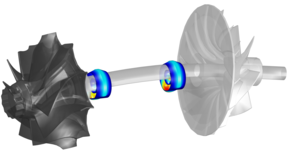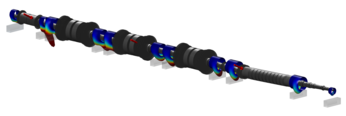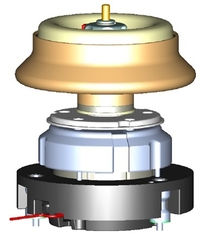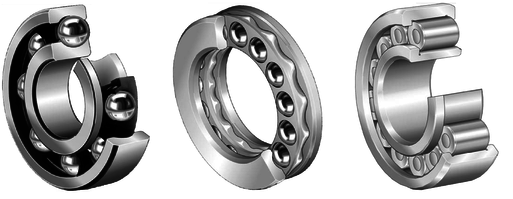Dynamic systems
The chair conducts research on dynamic systems. Thereby, the dualism between numerical simulation and experimental analyses/verifications allows a holistic investigation of complex systems. In this regard, we enhance conventional simulation techniques by additional (normally nonlinear) effects and combine established measurement methods with new approaches.
Modelling of rotordynamic behaviour
Simulating the dynamic behaviour of a system is a crucial part of the design process to account for various aspects such as bearing loads, stresses, lifetime, etc. With respect to rotordynamic systems, effects such as resonance and sub- or superharmonic oscillations can have a major impact on the firstly mentioned aspects. As a result of the system complexity and the frequent occurrence of nonlinear interactions we use numerical methods, which incorporate all significant influences. For these simulations, we use standard multibody systems as well as a hybrid multibody-rotordynamics-approach integrated in the software EMD (Homepage), which is an inhouse-development. Contact
 |
 |
 |
||||||
| Turbocharger | Turbine train | Centrifuge | ||||||
Modelling of nonlinear vibration processes
It is essential for the simulation of nonlinear vibration processes to model all nonlinearities appropriately to ensure realistic results. For this reason, one important aspect of our research is to formulate the stiffness and damping behaviour as a function of the kinematic states of the system. This allows a closed-loop-description of all dependencies in the system. With this approach, both linear characteristics (constant stiffness and constant damping) and nonlinear characteristics and influences such as contact, stiffness and nonlinear material behaviour can be considered. Contact
Experimental determination of stiffness and damping characteristics
The knowledge of system properties (mass, stiffness, damping characteristics) is crucial for model-based investigations of dynamic systems and their behaviour. On the one hand, these data can be used to validate numerical simulations. On the other hand, the determination of real (e.g. frequency-dependent) system characteristics and their use for subsequent analyses is possible. We use different measurement systems such as force sensors, strain gauges, laser triangulation sensors and piezo-electric acceleration sensors. Contact
 |
| Measurement of the stiffness and damping protperties of an elastomer-element |
Measurement of structural vibrations in stationary AND rotating systems
Whilst the determination of stiffness and damping characteristics is often especially useful for bearing elements or elastomer components, it can also be very helpful to measure the vibration behaviour under operating conditions. For that purpose, two different measurement systems are available at the chair. Firstly, we can record the structural vibrations spatially by using a 3D-laser-scanning-vibrometer. Secondly, surfaces of rotating components can be measured with the help of a derotator. The derotator works with a laser beam and a rotating optic transmitting the beam to trace body fixed points on the object. This enables the investigation of very complex excitation mechanisms. Contact
 |
| Determination of the structural oscillations of an air screw in the rotating system |
Diagnosis of bearing failures
Amongst slide bearings, rolling bearings are the bearing elements used most commonly. They are a crucial machine element, not only for machine lifetime, but also for acoustics. Flaws on the running surface as a result of high loads (pitting, false brinelling) lead to characteristic vibration problems, which can be detected from signals of bearing monitoring setups with the help of suitable filters. Afterwards, model-based determination of the kind and the position of the flaw is possible, which leads to a maximisation of the maintenance interval and the reduction of outage durations. Contact
 |
 |
|||
|
Bearing variants (Source: Goreczka, S. Adaptives Verfahren für die Zustandsüberwachung von Wälzlagern bei unbekannten Schädigungen und unter variablen Betriebsbedingungen. Dissertation, 2013.) |
Disc model for contact detection in roller bearings (Source: Daniel, C. Simulation von gleit- und wälzgelagerten Systemen auf Basis eines Mehrkörpersystems für rotordynamische Anwendungen. Dissertation, 2013.) |
|||





